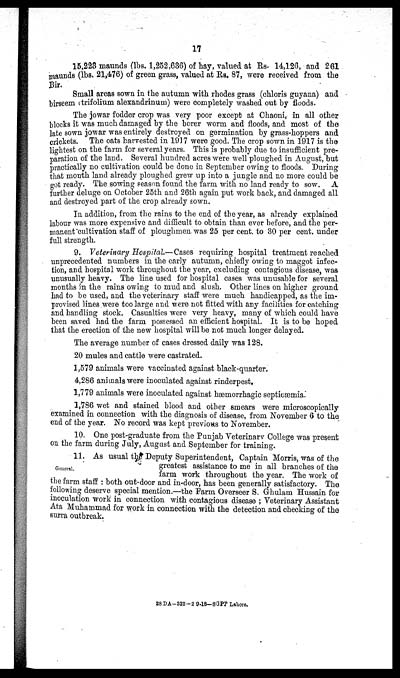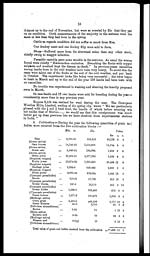Medicine - Veterinary > Civil Veterinary Departments > 1894-1932 - Annual report of the Punjab Veterinary College and of the Civil Veterinary Department, Punjab > 1909-1919 > 1917-1918 - Annual report on the Punjab Veterinary College, Civil Veterinary Department, Punjab, and the Government cattle farm, Hissar, for the year 1917-18
(435) Page 17
Download files
Individual page:
Thumbnail gallery: Grid view | List view

17
15,223 maunds (lbs. 1,252,636) of hay, valued at Rs. 14,126, and 261
maunds (lbs. 21,476) of green grass, valued at Rs. 87, were received from the
Bir.
Small areas sown in the autumn with rhodes grass (chloris guyana) and
birseem (trifolium alexandrinum) were completely washed out by floods.
The jowar fodder crop was very poor except at Chaoni, in all other
blocks it was much damaged by the borer worm and floods, and most of the
late sown jowar was entirely destroyed on germination by grass-hoppers and
crickets. The oats harvested in 1917 were good. The crop sown in 1917 is the
lightest on the farm for several years. This is probably due to insufficient pre-
paration of the land. Several hundred acres were well ploughed in August, but
practically no cultivation could be done in September owing to floods. During
that month land already ploughed grew up into a jungle and no more could be
got ready. The sowing season found the farm with no land ready to sow. A
further deluge on October 25th and 26th again put work back, and damaged all
and destroyed part of the crop already sown.
In addition, from the rains to the end of the year, as already explained
labour was more expensive and difficult to obtain than ever before, and the per-
manent cultivation staff of ploughmen was 25 per cent. to 30 per cent. under
full strength.
9. Veterinary Hospital.—Cases requiring hospital treatment reached
unprecedented numbers in the early autumn, chiefly owing to maggot infec-
tion, and hospital work throughout the year, excluding contagious disease, was
unusually heavy. The line used for hospital cases was unusable for several
months in the rains owing to mud and slush. Other lines on higher ground
had to be used, and the veterinary staff were much handicapped, as the im-
provised lines were too large and were not fitted with any facilities for catching
and handling stock. Casualties were very heavy, many of which could have
been saved had the farm possessed an efficient hospital. It is to be hoped
that the erection of the new hospital will be not much longer delayed.
The average number of cases dressed daily was 128.
20 mules and cattle were castrated.
1,579 animals were vaccinated against black-quarter.
4,286 animals were inoculated against rinderpest.
1,779 animals were inoculated against hæmorrhagic septicæmia.
1,786 wet and stained blood and other smears were microscopically
examined in connection with the diagnosis of disease, from November 6 to the
end of the year. No record was kept previous to November.
10. One post-graduate from the Punjab Veterinary College was present
on the farm during July, August and September for training.
General.
11. As usual the Deputy Superintendent, Captain Morris, was of the
greatest assistance to me in all branches of the
farm work throughout the year. The work of
the farm staff : both out-door and in-door, has been generally satisfactory. The
following deserve special mention.—the Farm Overseer S. Ghulam Hussain for
inoculation work in connection with contagious disease ; Veterinary Assistant
Ata Muhammad for work in connection with the detection and checking of the
surra outbreak.
28 DA-322-2 9-18—SGPP Lahore.
Set display mode to: Large image | Zoom image | Transcription
Images and transcriptions on this page, including medium image downloads, may be used under the Creative Commons Attribution 4.0 International Licence unless otherwise stated. ![]()
| Permanent URL | https://digital.nls.uk/75532706 |
|---|
| Additional NLS resources: |
|---|




